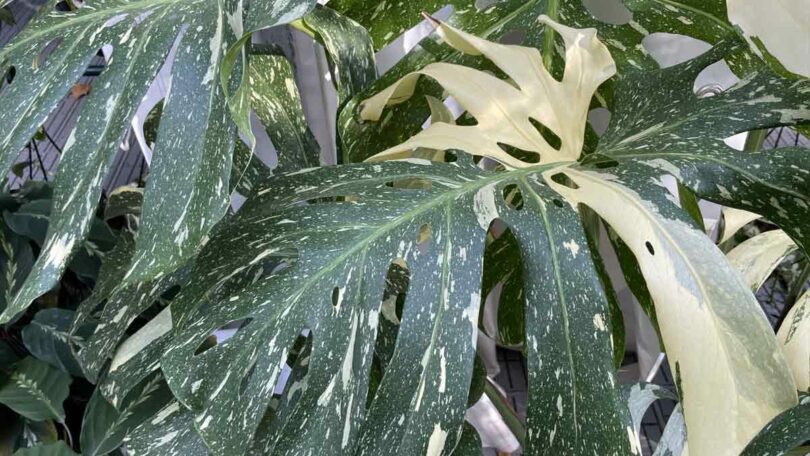A Variegated Monstera
With large variegated leaves Monstera Thai Constellation is a stunning indoor plant and also easy to grow.

It requires the same growing conditions as most other Monstera deliciosa varieties and is a little easier to grow than Monstera albo Borsgiana.
This a variegated variety created by tissue culture in Thailand, Amazing creamy white variegation against deep green and the variegation generally becomes more pronounced as the plant ages.
This is a fairly stable variegated plant which means the foliage does not very often revert to plain green as is the case with some other variegated Monstera types.
How To Grow Monstera Thai Constellation – 5 Care Factors
The main care factors are Light, Temperature, Soil, Watering and Fertiliser. Soil and watering work min combination along with your own watering habits and climate.
- Lighting
Bright indirect light, more light than a normal the plan green Monstera deliciosa as it needs extra light to photosynthesis. So as much bright indirect light as you can give it. Direct sun is not recommended as this can cause leaf burn.
Grow lights can be used for extra light if needed. - Potting Soil
A free draining potting mix is essential to prevent root problems. A light potting mix also allows air into the soil which helps with root growth.
You can use a normal potting mix with 20% perlite mixed through.
We prefer :
30% normal potting mix
30% succulent and cacti mix
20% perlite
20% charcoal - Watering
Although most of the growing instructions are the same as for other Monstera delicosa plants watering is a little more critical.
This variegated form does like a wet/dry cycle however it is more sensitive to the extremes. It needs the soil to dry between waterings, not just the top part, and it will not tolerate very wet soils.
Don’t water again until the soil dries.
In winter, water less often
When you water the water should drain quickly through the drainage holes at the bottom of the pot, if it doesn’t, either add more drainage material to the potting mix or water a lot less often. - Temperature
Understanding the temperature range is another key factor in growing this plant. Indoors temperatures from 18°C to 24°C are adequate.
They will grow in slightly cooler temperatures, and will prefer a few degrees more so 16C – 30C around 22°C is achievable and a good temperature to aim for. however of most this is difficult to maintain indoors. Humidity is also important. The nighttime drop should not be to great 10°C. - Fertiliser
A balanced liquid fertiliser designed for indoor plants is best.
Apply every 4 – 6 weeks from spring through summer when the plant is in active growth.In cooler months (autumn into winter) cut back on fertiliser to every 10 weeks.
Over fertilising will cause a build up salts in the soil which is not good for growth.
More Information
The right Potting mix and adequate drainage holes are very important. Pumice, activated charcoal, Leca and Akadama are suggested additives to improve drainage. These all work in slightly different ways.
We do like charcoal, its light helps aeration and promotes healthier root growth.
Rather than have one small drainage hole, extra drainage holes can be drilled using the appropriate stepped drill bit. Try adding 4 extra drainage holes around the bottom of the pot.
Common Problems
Wilting, Yellowing leaves and poor growth
These can all be caused by root rot. This is usually caused by overwatering, a poorly drained pot, or soil that retains too much water.
Repotting is also required every 2- 3 yearsas potting mix componenets break down, become finer and therefore drainage becomes a problem.
